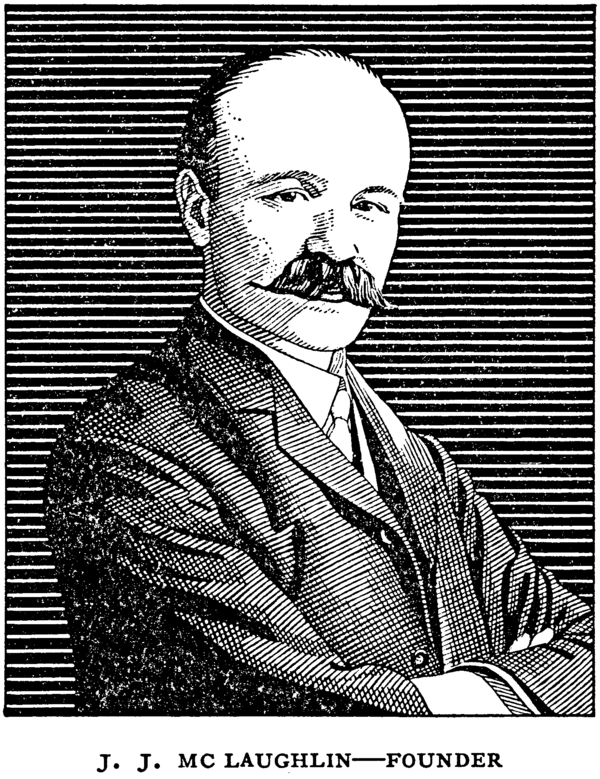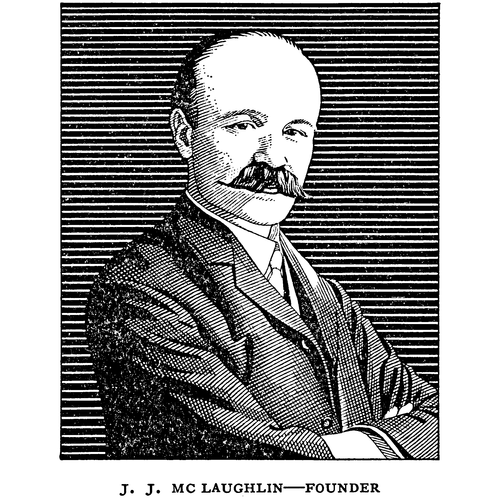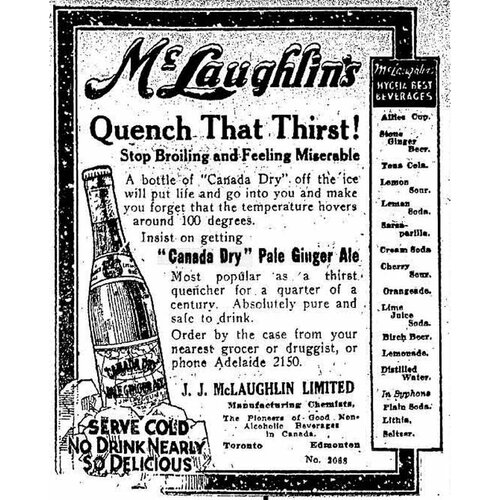
Source: Link
McLAUGHLIN, JOHN JAMES pharmacist and manufacturer; b. 2 March 1865 near Enniskillen, Durham County, Upper Canada, son of Robert McLaughlin* and Mary Smith; m. 23 Oct. 1890 Maude Christie in New York City, and they had a daughter and three sons, one of whom died in infancy; d. 28 Jan. 1914 in Toronto.
A grandson of immigrants from the north of Ireland, J. J. McLaughlin attended public school in Enniskillen. After his father had moved his carriage-building business to Oshawa, Jack, as he was known, completed his studies at the high school there. He hoped to be a doctor, but decided on a career in pharmacy; he was apprenticed in Oshawa and in 1885 he graduated from the Ontario College of Pharmacy in Toronto. He moved to Brooklyn (New York City), where he took a postgraduate course in pharmacy, worked as a dispenser, and then managed one of Brooklyn’s largest pharmacies. It was there that he conceived of starting in the soda-water and mineral-water business.
Arising out of a centuries-old belief in the salubrity of natural mineral waters, an industry had developed in Europe and the United States by the late 1880s for the manufacture and distribution of bottled carbonated beverages. With the addition of flavoured syrups and ingredients such as ginger extract, they were consumed more and more for pleasure, often at drugstores. McLaughlin had arrived in Brooklyn at exactly the right time to combine his background in pharmacy with his entrepreneurial skills.
Returning to Toronto in 1890 after a study tour of European producers, McLaughlin set himself the goal of developing a pale, dry ginger ale, ostensibly as a non-alcoholic rival for champagne but more likely in the hope of surpassing the popular ginger ales then on the market. In a shop near City Hall he began producing mineral water and soda water, and he distributed them in siphon-bottles, which he is credited with introducing to consumers in Toronto. Despite competition – there were about 12 producers in the city in 1891 – the business grew enough to warrant a move to larger premises, at Queen and Victoria streets. McLaughlin’s advertisements were often quite outspoken: “Don’t suicide by drinking” city water, one warned. Still styling himself a “manufacturing chemist,” McLaughlin expanded his line to include Hygeia Sparkling Waters, sarsaparilla, lemon sour, cream soda, ginger beer, cola, fruit syrups, crushed fruits, and other supplies. In 1893 success necessitated another move, to Sherbourne Street. Maude McLaughlin was an invaluable help in the development of the business; she often offered suggestions as to how recipes might be improved and was to provide the slogan for the brand of ginger ale that McLaughlin would make famous.
To facilitate expansion, McLaughlin opened shops to manufacture the metal, wooden, and marble equipment needed to carbonate, blend, and serve soft drinks in drugstores, restaurants, and department stores and to make other soda parlour essentials such as ice-cream. These products became the core of his business. Italian marble was imported for counter tops. Among the most prestigious clients were the Hudson’s Bay Company in Edmonton, the Robert Simpson Company in Toronto, and the Orpheum Store in Montreal.
Soon after the turn of the century, the sweet, dark gold, Belfast-style ginger ale bottled and sold by McLaughlin, and patterned after a ginger ale long popular in Ireland and Canada, was changed to a less sugared substance of lighter colour. To market it, the slogan that would become known the world over, “The Champagne of Ginger Ales,” and a label that featured a map of Canada and a beaver were devised. On 25 Oct. 1905 J. J. McLaughlin Limited was incorporated; the following month an application was filed for the trademark, Canada Dry Pale Dry Gingerale. By 1906 the drink had been launched. Rapid growth followed, and branch plants were opened in Winnipeg and Edmonton. So successful was Canada Dry, the trade name for which was officially registered on 18 Jan. 1907, that several substantial offers were made to McLaughlin’s company to sell the formula and to establish a factory in the United States, but all offers were rejected. Only in 1922 would McLaughlin’s brothers, George William and Robert Samuel*, back the establishment of a plant in New York City under the name of Canada Dry Gingerale Incorporated.
Since the 1890s McLaughlin had suffered from ill health, although, according to the Canadian Pharmaceutical Journal, he “all the time kept in touch with his business.” He died of a heart attack in 1914 at his home at 81 Glen Road and was buried in St James’ Cemetery. Described by the Toronto Daily Star as “one of Toronto’s shrewdest businessmen,” McLaughlin, less widely publicized than his car-making brothers, died as he had lived, with quiet dignity. A reserved and scholarly man who spent much of his leisure reading and golfing, he took a special interest in civic affairs, attended Rosedale Presbyterian Church, and privately performed many philanthropic acts. At the same time, he displayed the ingenuity and entrepreneurial vision needed to pioneer an important industry in Canada.
Information concerning J. J. McLaughlin and the companies he founded was graciously provided by Richard Brown (now retired) and Wilfred Cross of Canada Dry Limited (North York, Ont.) and, in a telephone interview, by Mrs Marjorie McLaughlin of Toronto, a daughter-in-law of the subject.
AO, RG 22-305, no.28441. Canada Dry Limited, Historical file material (articles, brochures, etc.). Financial Post (Toronto), 24 July 1930: 23. Globe, 28 Jan. 1914. Toronto Daily Star, 28 Jan. 1914. Canadian Pharmaceutical Journal (Toronto), 47 (1913–14): 328. Directory, Toronto, 1891–1913. Dorothy McLaughlin Henderson, Robert McLaughlin: carriage builder (Toronto, 1972). The mercantile agency reference book . . . (Montreal), July 1909: 605. J. E. Middleton, The municipality of Toronto: a history (3v., Toronto and New York, 1923), 3: 248. J. J. Riley, A history of the American soft drink industry; bottled carbonated beverages, 1807–1957 (Washington, 1958; repr. New York, 1972). Heather Robertson, Driving force: the McLaughlin family and the age of the car (Toronto, 1995).
Cite This Article
M. Patricia Bishop, “McLAUGHLIN, JOHN JAMES,” in Dictionary of Canadian Biography, vol. 14, University of Toronto/Université Laval, 2003–, accessed January 5, 2026, https://www.biographi.ca/en/bio/mclaughlin_john_james_14E.html.
The citation above shows the format for footnotes and endnotes according to the Chicago manual of style (16th edition). Information to be used in other citation formats:
| Permalink: | https://www.biographi.ca/en/bio/mclaughlin_john_james_14E.html |
| Author of Article: | M. Patricia Bishop |
| Title of Article: | McLAUGHLIN, JOHN JAMES |
| Publication Name: | Dictionary of Canadian Biography, vol. 14 |
| Publisher: | University of Toronto/Université Laval |
| Year of publication: | 1998 |
| Year of revision: | 1998 |
| Access Date: | January 5, 2026 |




